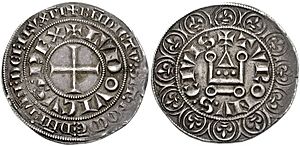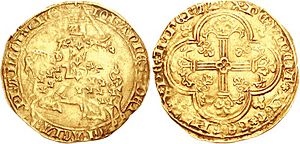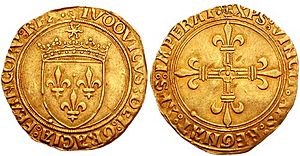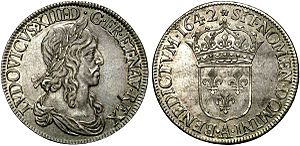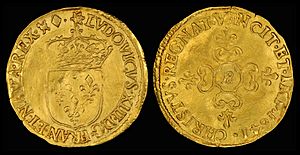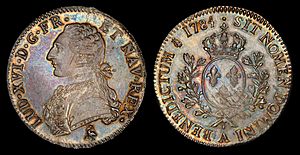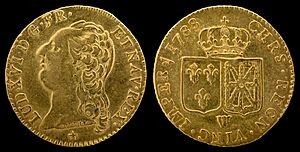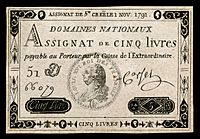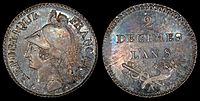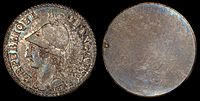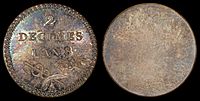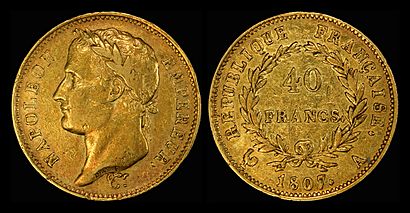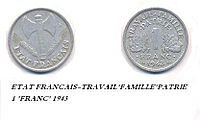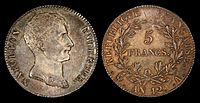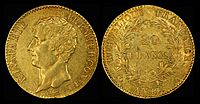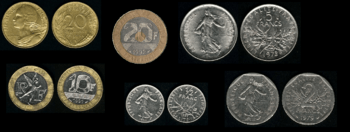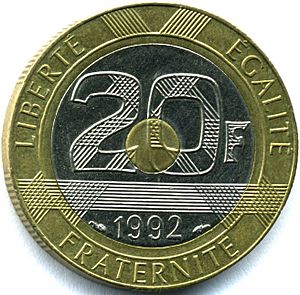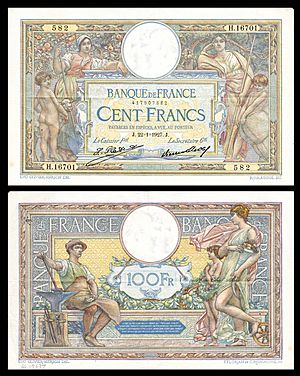French franc facts for kids
Quick facts for kids French franc |
|||||
|---|---|---|---|---|---|
|
|||||
| ISO 4217 Code | FRF | ||||
| User(s) | None; previously: France, Monaco, Andorra (until 2002); Saar, Saarland (until 1959) |
||||
| ERM | |||||
| Since | 13 March 1979 | ||||
| Fixed rate since | 31 December 1998 | ||||
| Replaced by €, non cash | 1 January 1999 | ||||
| Replaced by €, cash | 17 February 2002 | ||||
| € = | 6.55957 F | ||||
| Pegged by | KMF, XAF & XOF, XPF, ADF, MCF | ||||
| Subunit | |||||
| 1⁄100 | centime | ||||
| Symbol | F or Fr | ||||
| Nickname | balles (1 F); sacs (10 F); bâton, brique, patate, plaque (10,000 F) | ||||
| Coins | |||||
| Freq. used | 5, 10, 20 centimes, 1⁄2 F, 1 F, 2 F, 5 F, 10 F | ||||
| Rarely used | 1 centime, 20 F | ||||
| Banknotes | |||||
| Freq. used | 20 F, 50 F, 100 F, 200 F, 500 F | ||||
The franc (also known as the French franc or FF) was the money used in France for a long time. It was first used between 1360 and 1641 as the name for certain coins. Then, it was brought back in 1795 in a new, simpler system.
After many years, the franc changed in 1960. A "new franc" (NF) was worth 100 of the old francs. Even after the new franc was introduced, some people still talked about prices in "old francs" for expensive things. The French franc was a very important currency around the world in the 1800s and 1900s.
In 2002, the franc was replaced by the Euro. The exchange rate was fixed at 6.55957 francs for 1 euro.
Contents
- History of the French Franc
- Early French Money: From Charlemagne to Louis IX
- The Franc Appears: Hundred Years' War and Beyond
- From Louis XIII to the French Revolution
- The French Revolution and the Franc
- Napoleon and the Franc Germinal
- The Latin Monetary Union (1865)
- World War I and the Franc's Decline
- World War II and Occupation Francs
- The Post-War Period and the New Franc
- The Euro Takes Over
- French Franc Coins
- French Franc Banknotes
- Where Else Was the Franc Used?
- See also
History of the French Franc
The French Franc's story goes back to an old money system from the 700s AD. This system, called the Carolingian monetary system, used a "livre" (pound) of silver. It was divided into 20 "sols" (shillings) and each sol had 12 "deniers" (pennies). For a long time, only the denier was a real coin. The sol and livre were just ways to count money.
Early French Money: From Charlemagne to Louis IX
Charlemagne's Money System (781 AD)
Emperor Charlemagne started this money system in 781 AD. It spread across much of Western Europe. The first livre weighed about 407.92 grams of silver. The denier weighed about 1.7 grams of silver.
Capetian Dynasty and Money Changes (around 1000 AD)
Around the year 1000, under the Capetian dynasty, the livre and denier had less silver. French kings tried to keep money values the same. But many local rulers also made their own coins. They often made their coins with less precious metal when they needed money. This made money less valuable.
One type of money, the Livre Tournois, became the main way to count money in France.
King Louis IX and the Gros Tournois (1266)
The Livre Tournois became very important during the time of King Louis IX. He introduced a new silver coin called the Gros tournois. This coin was worth 1 sol (12 deniers) in the Touraine region of France. It was a popular coin because it was reliable and easy to use.
Philip IV and Changes to Coin Values (1317)
Later, under King Philip IV, the denier's value was lowered. In 1317, the Gros Tournois was worth 15 deniers Tournois. This set a fixed value between the different types of deniers.
The Franc Appears: Hundred Years' War and Beyond
Money During the Hundred Years' War (1361)
The Hundred Years' War against England (starting in 1337) made France's money problems worse. The government had to lower the value of the French livre even more.
In 1361, a new gold coin called the franc was created. It was worth 1 livre Tournois. This gold franc was introduced in 1360 to pay the ransom of King John II of France. The coin showed the king on a horse, so it was called franc à cheval (meaning "free on horse"). The word "franc" also came from the Latin words on the coin, Francorum Rex ("King of the Franks").
Charles V and Stable Money (1365)
After his father's death, Charles V worked to make the money stable. In 1365, he introduced a new gold coin, also worth one livre tournois. This coin showed the king standing and was called a franc à pied. Charles made fewer, but better quality, gold coins. This helped make the franc known as stable money.
Louis XI and the Écu au Soleil (1475)
By the late 1400s, during the reign of Louis XI, the value of money changed again. A new gold coin, the écu au soleil, was introduced. By the end of the 15th century, France started to have a more unified money system, stopping different local currencies.
Valois-Angoulême Kings and Inflation (1549)
In the 1500s, a lot of gold and silver came from the Americas. This caused inflation (prices going up) in Europe. The value of the French livre dropped a lot. Larger silver coins, like the silver franc, were also made.
In 1577, Henry III tried to make French money stable again. He brought back the franc, but this time as a silver coin worth one livre tournois. This silver franc was used until 1641. Even after it stopped being a coin, people still used "franc" to mean one livre tournois.
From Louis XIII to the French Revolution
Louis XIII and New Coins (1641)
In the 1600s, King Louis XIII stopped using the old franc and ecu coins. He introduced new coins based on Spanish money. The "Louis d’Argent" was a silver coin, and the "Louis d'Or" was a gold coin. He also made the Livre Tournois the only official way to count money.
Louis XV and More Changes (1726)
During the early 1700s, France faced more money problems. Under King Louis XV, new silver and gold coins were introduced in 1726. The silver Écu was worth 6 livres, and the gold Louis d'Or was worth 24 livres.
Louis XVI and the Franc's Return (1785)
By 1785, under King Louis XVI, the value of gold increased. This led to changes in the gold content of the Louis d'Or. In 1795, the livre tournois was officially replaced by the French Franc. One franc was worth slightly more than one livre.
The French Revolution and the Franc
The National Convention of Revolutionary France officially created the decimal "franc" in 1795. This meant 1 franc was equal to 10 "décimes" and 100 "centimes." It was made from 4.5 grams of pure silver. This was a bit less than the old livre.
From then on, coins clearly showed their value, like "5 FRANCS." This stopped the old practice where kings could change the value of coins whenever they wanted. The franc became France's official money in 1799.
France was a leader in using the metric system for measurements. It was also one of the first countries to switch to a decimal currency. This means the money was based on units of 10, like our modern money.
During the Revolution, gold and silver coins were taken out of use. People used paper money called "assignats" instead. These were supposed to be backed by the value of church properties taken by the government. However, too many assignats were printed, and their value dropped quickly. This led to very high hyperinflation (prices rising extremely fast).
Napoleon and the Franc Germinal
In 1800, the Banque de France (Bank of France) was created to make the national currency. In 1803, the Franc germinal was introduced. This franc was based on both gold and silver, with a fixed value between the two metals. This system worked well and continued even after Napoleon's rule.
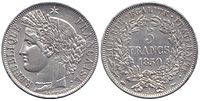
The new coins showed Napoleon like a Roman emperor. First, they said "Bonaparte Premier Consul." After he became emperor in 1804, they said "Napoleon Empereur." These gold coins were often called Gold Napoleons. This money system lasted until 1914.
The Latin Monetary Union (1865)
France was a founding member of the Latin Monetary Union (LMU). This was a group of countries, mostly in Europe, that agreed to use a common currency system. The LMU was based on the franc germinal. Countries like Switzerland and Belgium also used the franc. Other countries, like Spain, had their own currency names (like the peseta) but they were worth the same as the franc. In 1873, the LMU switched to using only gold as the standard for their money.
World War I and the Franc's Decline
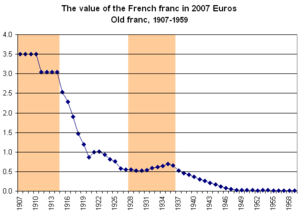
When World War I started, France stopped using gold as the standard for its money. The war cost a lot, and printing more money to pay for it made the franc much less valuable. Its buying power dropped by 70% between 1915 and 1920.
After a brief recovery, the franc lost even more value. This was partly because the United States insisted that France repay its war debts quickly. The franc's value kept dropping until 1959, when it was worth less than 2.5% of its 1934 value.
World War II and Occupation Francs
During the German occupation of France (1940–44), the franc was linked to the German Reichsmark. The exchange rate was 20 francs for 1 Reichsmark. Coins were changed to show the words Travail, famille, patrie (Work, Family, Fatherland) instead of the French Republic's motto.
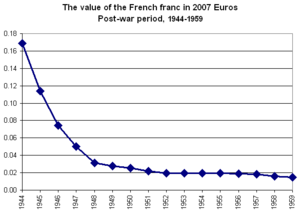
After France was freed, the US tried to introduce its own "occupation franc." But General De Gaulle prevented this.
The Post-War Period and the New Franc
After World War II, France lowered the value of its currency several times. By 1949, 980 francs were equal to 1 British Pound. By 1958, 493.7 francs were equal to 1 US Dollar.
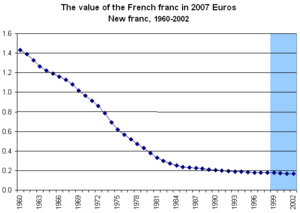
In January 1960, a big change happened. The French franc was revalued, and 100 old francs became one nouveau franc (new franc). The abbreviation "NF" was used for a few years. Old 1-franc and 2-franc coins were still used as new centimes.
Even after this change, prices continued to rise. The franc's value kept going down. By the time the Euro replaced the franc in 1999, the franc was worth less than one-eighth of its original 1960 value.
Many French people still used the term "old francs" for large amounts, like for houses or cars. This continued even after the euro was introduced. Lottery prizes were often advertised in "centimes" (which were like the old francs) to make the prizes seem bigger.
All franc coins and banknotes stopped being valid money in January 2002, when the Euro became the official currency.
The Euro Takes Over
From January 1, 1999, the value of the French franc was permanently set against the Euro: €1 was equal to 6.55957 francs. Euro coins and notes completely replaced the franc between January 1 and February 17, 2002.
French Franc Coins
Coins Before World War I
In August 1795, the franc replaced the old livre. It was divided into 10 décimes (tenths) and 100 centimes (hundredths). Copper coins were made for 1 and 5 centimes, and 1 and 2 décimes. After 1801, copper coins became rare.
The 5-centime copper coin was often called a sou.
During Napoleon's time as First Consul (1799–1804), silver francs were made. The 5-franc coin was introduced in 1801–02. Half-franc, 1-franc, and gold 40-franc coins came later.
The 5-franc silver coin was called an écu, like an old coin from before the Revolution.
New bronze coins were introduced from 1848. These included 1, 2, 5, and 10-centime coins. The smallest silver coin became the 20-centime coin.
Gold coins also changed. New gold coins for 5, 10, 50, and 100 francs were introduced. The 20-franc gold coin was often called a "napoléon." The 100-franc gold coin was sometimes called a "monaco."
Nickel 25-centime coins were introduced in 1903.
Coins During World War I
World War I brought big changes. Gold coins were stopped, and the franc lost value. Smaller coins with holes in the middle were introduced for 5, 10, and 25 centimes. These were made of nickel or cupro-nickel. In 1920, 1 and 2-centime coins were stopped. Silver coins were no longer made. Instead, aluminum-bronze coins for 50 centimes, 1 franc, and 2 francs were introduced.
Coins from World War II to the New Franc
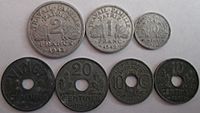
During World War II, coins changed a lot. In 1941, aluminum was used for 50 centimes, and 1, 2, and 5 francs. This was because copper and nickel were needed for the war. In 1942, under the French Vichy State, new coins were made of zinc and aluminum. These were stopped in 1944.
After the war, fast inflation meant that coins worth less than 1 franc were no longer used. New coins for 10, 20, 50, and 100 francs were introduced.
New Franc Coins (1960-2002)
In 1960, the new franc was introduced. It was worth 100 old francs. New coins were made:
- 1 and 5 centimes (stainless steel)
- 10, 20, and 50 centimes (aluminum-bronze)
- 1 franc (nickel)
- 5 francs (silver)
Silver 10-franc coins were introduced in 1965. Later, in the 1970s, nickel and copper-nickel coins replaced the silver ones. Nickel 2-franc coins were introduced in 1979. Bimetallic (two metals) 10-franc coins came in 1988, and trimetallic (three metals) 20-franc coins in 1992.
| 20 Centime with Marianne on Obverse. | |
|---|---|
 |
|
| Front: Marianne wearing the Phrygian cap of liberty | Back: Coin value and French motto: "Liberté, égalité, fraternité" |
| This coin was made from 1962 to 2001. | |
A silver 50-franc coin was made from 1974 to 1980. It was the largest silver coin ever made in France. But it was stopped when the price of silver went up. In 1982, a 100-franc silver coin was introduced.
All French franc coins were officially stopped in 2005. You can no longer exchange them at the bank.
At the time the Euro took over on January 1, 2002, these coins were in use:
| French Franc Coins (valid in 2001) | ||||||||
|---|---|---|---|---|---|---|---|---|
| Image | Value | Equivalent in euros | Diameter | Weight | Material | Front Side | Back Side | Years Made |
| 1 centime | €0.0015 | 15 mm | 1.65 g | stainless steel | sheath of wheat | coin value | 1960–2001 | |
| 5 centimes | €0.0075 | 17 mm | 2.00 g | aluminum-bronze | Marianne and country name | coin value; national motto (Liberté, Egalité, Fraternité); date | 1966–2001 | |
| 10 centimes | €0.015 | 20 mm | 3.00 g | 1962–2001 | ||||
| 20 centimes | €0.030 | 23.5 mm | 4.00 g | 1962–2001 | ||||
| 1⁄2 franc | €0.076 | 19.5 mm | 4.50 g | nickel | The Sower; country name | coin value; olive branch; date; national motto (Liberté, Egalité, Fraternité) | 1965–2001 | |
| 1 franc | €0.152 | 24 mm | 6.00 g | 1960–2001 | ||||
| 2 francs | €0.305 | 26.6 mm | 7.50 g | 1979–2001 | ||||
| 5 francs | €0.760 | 29.0 mm | 10.0 g | nickel-clad cupronickel | 1970–2001 | |||
| 10 francs | €1.52 | 22.3 mm | 6.50 g | aluminum-bronze (ring); nickel (center) | "RF"; Le Génie de la Liberté | value; pattern; date; national motto (Liberté, Egalité, Fraternité) | 1988–2001 | |
| 20 francs | €3.05 | 27.0 mm | 9.00 g | aluminum-bronze (outer ring and center); nickel (middle ring) | Country name; Mont-Saint-Michel | value; pattern; date; national motto (Liberté, Egalité, Fraternité) | 1992–2001 | |
- 1 centime (about 0.15 euro cents): made of stainless steel, not used much.
- 5, 10, 20 centimes: made of aluminum-bronze.
- 1⁄2, 1, 2 francs: made of nickel.
- 5 francs: made of nickel-clad copper-nickel.
- 10 francs: made of two different metals.
- 20 francs: made of three different metals, not very common.
- 100 francs: made of silver, rarely used for everyday shopping.
Exchanging Franc Coins for Euros
You could exchange franc coins for euros at the Banque de France until February 17, 2005. The exchange rate was fixed at 6.55957 francs for 1 euro. Banknotes could be exchanged until February 17, 2012.
French Franc Banknotes
The first paper money for the franc was issued in 1795. These were "assignats" with values up to 10,000 francs.
In 1800, the Bank of France started printing banknotes, first for 500 and 1000 francs. Later, other values like 100, 200, 5, 20, and 50 francs were added.
During World War I, 10 and 1000-franc notes were introduced. Even though new coins were made in the 1930s, the banknotes for 5, 10, and 20 francs stayed in use. In 1938, 5000-franc notes were added.
In 1944, the Allies (who helped free France) introduced dollar-like paper money in France.
After World War II, 5, 10, 20, 50, and 100-franc notes were replaced by coins. In 1954, 10,000-franc notes were introduced.
Banknotes in 1959 (Old Francs)
When the new franc was introduced in 1959, these banknotes were in use:
- 500 francs: showing Victor Hugo
- 1000 francs: showing Cardinal de Richelieu
- 5000 francs: showing Henri IV
- 10,000 francs: showing Bonaparte 1st consul
The first new franc banknotes were actually old notes with the new values printed on them. For example, a 500-franc note became a 5-new franc note. Later, new banknotes with only the new values were printed.
Banknotes in Circulation (1993–1997 series)
These banknotes were in use when the franc was replaced by the Euro:
- 20 francs (€3.05): showing Claude Achille Debussy (a famous composer)
- 50 francs (€7.62): showing Antoine de Saint-Exupéry (author of The Little Prince)
- 100 francs (€15.24): showing Paul Cézanne (a famous painter)
- 200 francs (€30.49): showing Gustave Eiffel (who designed the Eiffel Tower)
- 500 francs (€76.22): showing Pierre and Marie Curie (famous scientists)
You could exchange these banknotes at the French central bank until February 17, 2012.
-
10-franc banknote (1976) (back) Hector Berlioz
-
20-franc banknote (1983) (back) Claude-Achille Debussy
-
50 francs Antoine de Saint-Exupéry
-
100 francs Paul Cézanne
-
200 francs Gustave Eiffel
-
500 francs Marie Curie and Pierre Curie
| French Franc Banknotes (1968-1997 series) | ||||||||
|---|---|---|---|---|---|---|---|---|
| Image | Value | Equivalent in euros | Size | Front Side | Back Side | Watermark | Notes | Date Issued |
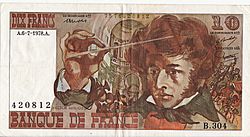 |
10 F | 140 x 75 mm | Hector Berlioz conducting his "Requiem" | Hector Berlioz, holding a guitar; Villa Medici, Rome | Hector Berlioz | 7 February 1974 | ||
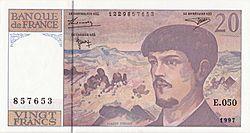 |
20 F | €3.05 | 140 x 75 mm | Claude Debussy, Opera "La Mer" | Claude Debussy, lake scene | Claude Debussy | 1980 | |
| 50 F | €7.62 | 150 x 80 mm | Maurice Quentin de la Tour, Palace of Versailles | Maurice Quentin de la Tour, St. Quentin city hall | Maurice Quentin de la Tour | 1976 | ||
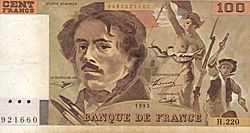 |
100 F | €15.24 | 160 x 85 mm | Eugène Delacroix, Liberty guiding the people | Eugène Delacroix, Place Furstenberg, Paris | Eugène Delacroix | 1978 | |
| 200 F | €30.49 | 172 x 92 mm | Montesquieu, Justicia | Montesquieu, La Brède castle | Montesquieu | 1981 | ||
| 500 F | €76.22 | 180 x 97 mm | Blaise Pascal, St. Jacques tower, Paris | Blaise Pascal, Port Royal des Champs monastery, Versailles | Blaise Pascal | 4 January 1968 | ||
| French Franc Banknotes (1993–1997 series) | ||||||||
|---|---|---|---|---|---|---|---|---|
| Image | Value | Equivalent in euros | Size | Front Side | Back Side | Watermark | Notes | Date Issued |
| 50 F | €7.62 | 123 x 80 mm | Antoine de Saint-Exupéry; Le Petit Prince (The Little Prince); "Latécoère 28" airplane | "Breguet 14" biplane | Antoine de Saint-Exupéry | In early notes, Saint-Exupéry's name was misspelled. | 20 October 1993 | |
| 100 F | €15.24 | 133 x 80 mm | Paul Cézanne | Fruit (a painting by Paul Cézanne) | Paul Cézanne | Has a special pattern to prevent copying. | 15 December 1997 | |
| 200 F | €30.49 | 143 x 80 mm | Gustave Eiffel; part of the Eiffel tower | Base of the Eiffel tower | Gustave Eiffel | 29 October 1996 | ||
| 500 F | €76.22 | 153 x 80 mm | Marie Curie and Pierre Curie | Laboratory tools | Marie Curie | 22 March 1995 | ||
Where Else Was the Franc Used?
The French franc was also used as money in Andorra (which didn't have its own national currency) and Monaco. In Monaco, it was used alongside the Monegasque franc and had the same value. All these currencies were replaced by the euro in 2002.
See also
 In Spanish: Franco francés para niños
In Spanish: Franco francés para niños
- French euro coins
- Economy of France
- Napoléon (coin)





